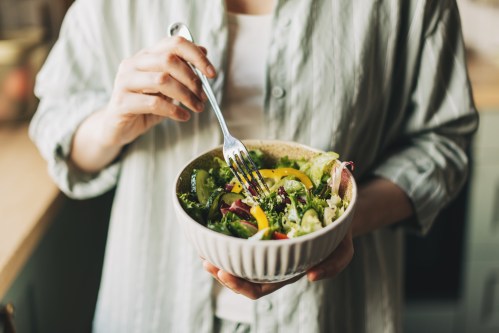Intimidating as it may seem, adopting sustainable eating and shopping habits doesn’t have to be hard—and if you’ve been following along with Well+Good’s 2022 ReNew Year program, you’ve already come to know this well. In fact, there are several small, simple steps you can take when it comes to buying groceries, meal prepping, and cooking at home that can make a big impact and help lower your personal food carbon footprint.
Experts in This Article
president and co-founder of Food Tank, a nonprofit focused on building a more sustainable food system.
Here, Danielle Nierenberg, president and co-founder of Food Tank, a nonprofit focused on building a more sustainable food system, shares her pro tips for doing just that.
6 sustainable eating tips to make dining in more eco-friendly
1. Stick to local and regionally grown foods
The closer you live to your food supply, the lower its carbon footprint will be. “And because regional food choices are not shipped hundreds or, even, thousands of miles, they tend to be more delicious,” Nierenberg says. Plus, they have the added benefit of contributing to the local economy.
2. Opt for perennial crops when possible
Nierenberg recommends incorporating perennials like asparagus, grapes, artichokes, and rhubarb into your diet because their longer life cycles (and deeper roots) help fortify soil against erosion and reduce runoff, both of which degrade soil’s ability to absorb and store carbon and keep it out of the atmosphere.
3. Shop for produce that’s in season
While it’s totally possible to find pretty much any fruit or veg year-round at major supermarkets, eating foods out of season comes at a higher cost in terms of environmental impact and carbon footprint, since they likely had to travel a long distance to get to you. Instead, Nierenberg recommends either planning meals around the harvest cycle of the region where you live or (if you really must have berries for your breakfast smoothie in winter, buy extra when they’re in season and freeze them. “Because they’re harvested and frozen at their peak, they maintain their nutritional value,” she says. Win-win!
4. Go for grass-fed
In general, swapping animal products for plant-based ones is the most effective, sustainable way to reduce your environmental impact because foods derived from animals have a larger carbon footprint and release more greenhouse gas (GHG) emissions. As a result, they contribute more to climate change, according to research published by the Oxford University Press.
But if you do decide to continue being a carnivore, Nierenberg recommends going the grass-fed route. Managed grazing is a form of regenerative agriculture that can help mitigate the impact of climate change by restoring soil fertility and biodiversity, which in turn helps the land store more carbon. (Just ensure that your meat is coming from a local or regional source.)
And in terms of your health, “grass-fed and organic meat and dairy tend to have more omega-3s and again, can support local economies,” she says.
5. Cook more at home
This may seem obvious, but, even in the midst of the farm-to-table (and farm-to-fast-food) movements that have made it possible to find more healthy options when dining out than ever, one of the most sustainable eating habit you can adopt is cooking more at home. And this is especially true if you’re sourcing your ingredients seasonally, from local and regional farmers.
6. Start cooking with food scraps
Food is the biggest source of waste in the United States—Americans create a pound of it per day on average. One way to reduce your production is by learning to cook with food scraps, as long as they aren’t the inedible kind.
For example: “Most of us only eat the florets from vegetables like broccoli, but the leaves can be tasty as a side dish instead of spinach,” Nierenberg says. But they can also be roasted with the florets or sautéed on their own with olive oil and salt and pepper, which is simple, flavorful, and will also add some healthy fat and spice.
Another favorite food scraps recipe of Nierenberg’s is a pesto from chef Haile Thomas of The Happy Org. “She suggests making pesto of almost anything that is wilting in your refrigerator—including surprising veggies like lettuce,” Nierenberg says. Blend with walnuts, pine nuts, and olive oil, and that leafy green pesto can be a delicious spread for bread and veggie sticks or poured over pasta.
Looking to hit refresh on your healthy habits this January? Check out our full 2022 ReNew Year program for expert-led plans for better sleep, nutrition, exercise, and self-care routines.
Sign Up for Our Daily Newsletter
Get all the latest in wellness, trends, food, fitness, beauty, and more delivered right to your inbox.
Got it, you've been added to our email list.











